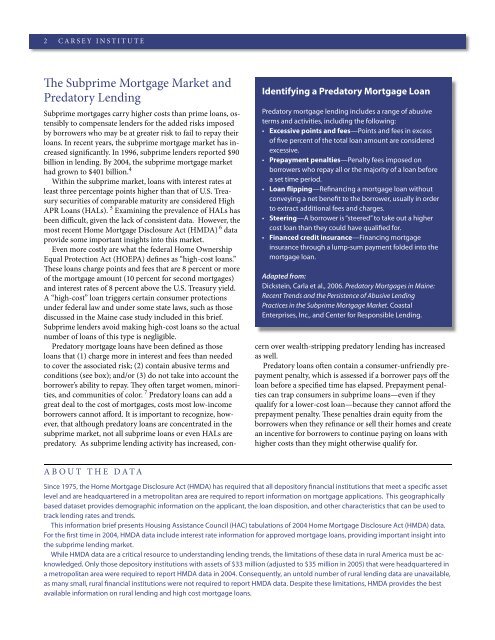You also want an ePaper? Increase the reach of your titles
YUMPU automatically turns print PDFs into web optimized ePapers that Google loves.
2 C A R S E Y I N S T I T U T E<br />
The Subprime Mortgage Market and<br />
<strong>Predatory</strong> <strong>Lending</strong><br />
Identifying a <strong>Predatory</strong> Mortgage Loan<br />
<strong>Predatory</strong> mortgage lending includes a range of abusive<br />
terms and activities, including the following:<br />
• Excessive points and fees—Points and fees in excess<br />
of five percent of the total loan amount are considered<br />
excessive.<br />
• Prepayment penalties—Penalty fees imposed on<br />
borrowers who repay all or the majority of a loan before<br />
a set time period.<br />
• Loan flipping—Refinancing a mortgage loan without<br />
conveying a net benefit to the borrower, usually in order<br />
to extract additional fees and charges.<br />
• Steering—A borrower is “steered” to take out a higher<br />
cost loan than they could have qualified for.<br />
• Financed credit insurance—Financing mortgage<br />
insurance through a lump-sum payment folded into the<br />
mortgage loan.<br />
Adapted from:<br />
Dickstein, Carla et al., 2006. <strong>Predatory</strong> Mortgages in Maine:<br />
Recent Trends and the Persistence of Abusive <strong>Lending</strong><br />
Practices in the Subprime Mortgage Market. Coastal<br />
Enterprises, Inc., and Center for Responsible <strong>Lending</strong>.<br />
Subprime mortgages carry higher costs than prime loans, ostensibly<br />
to compensate lenders for the added risks imposed<br />
by borrowers who may be at greater risk to fail to repay their<br />
loans. In recent years, the subprime mortgage market has increased<br />
significantly. In 1996, subprime lenders reported $90<br />
billion in lending. By 2004, the subprime mortgage market<br />
had grown to $401 billion. 4<br />
Within the subprime market, loans with interest rates at<br />
least three percentage points higher than that of U.S. Treasury<br />
securities of comparable maturity are considered High<br />
APR Loans (HALs). 5 Examining the prevalence of HALs has<br />
been difficult, given the lack of consistent data. However, the<br />
most recent Home Mortgage Disclosure Act (HMDA) 6 data<br />
provide some important insights into this market.<br />
Even more costly are what the federal Home Ownership<br />
Equal Protection Act (HOEPA) defines as “high-cost loans.”<br />
These loans charge points and fees that are 8 percent or more<br />
of the mortgage amount (10 percent for second mortgages)<br />
and interest rates of 8 percent above the U.S. Treasury yield.<br />
A “high-cost” loan triggers certain consumer protections<br />
under federal law and under some state laws, such as those<br />
discussed in the Maine case study included in this brief.<br />
Subprime lenders avoid making high-cost loans so the actual<br />
number of loans of this type is negligible.<br />
<strong>Predatory</strong> mortgage loans have been defined as those<br />
loans that (1) charge more in interest and fees than needed<br />
to cover the associated risk; (2) contain abusive terms and<br />
conditions (see box); and/or (3) do not take into account the<br />
borrower’s ability to repay. They often target women, minorities,<br />
and communities of color. 7 <strong>Predatory</strong> loans can add a<br />
great deal to the cost of mortgages, costs most low-income<br />
borrowers cannot afford. It is important to recognize, however,<br />
that although predatory loans are concentrated in the<br />
subprime market, not all subprime loans or even HALs are<br />
predatory. As subprime lending activity has increased, concern<br />
over wealth-stripping predatory lending has increased<br />
as well.<br />
<strong>Predatory</strong> loans often contain a consumer-unfriendly prepayment<br />
penalty, which is assessed if a borrower pays off the<br />
loan before a specified time has elapsed. Prepayment penalties<br />
can trap consumers in subprime loans—even if they<br />
qualify for a lower-cost loan—because they cannot afford the<br />
prepayment penalty. These penalties drain equity from the<br />
borrowers when they refinance or sell their homes and create<br />
an incentive for borrowers to continue paying on loans with<br />
higher costs than they might otherwise qualify for.<br />
A B O U T T H E D A T A<br />
Since 1975, the Home Mortgage Disclosure Act (HMDA) has required that all depository financial institutions that meet a specific asset<br />
level and are headquartered in a metropolitan area are required to report information on mortgage applications. This geographically<br />
based dataset provides demographic information on the applicant, the loan disposition, and other characteristics that can be used to<br />
track lending rates and trends.<br />
This information brief presents Housing Assistance Council (HAC) tabulations of 2004 Home Mortgage Disclosure Act (HMDA) data.<br />
For the first time in 2004, HMDA data include interest rate information for approved mortgage loans, providing important insight into<br />
the subprime lending market.<br />
While HMDA data are a critical resource to understanding lending trends, the limitations of these data in rural America must be acknowledged.<br />
Only those depository institutions with assets of $33 million (adjusted to $35 million in 2005) that were headquartered in<br />
a metropolitan area were required to report HMDA data in 2004. Consequently, an untold number of rural lending data are unavailable,<br />
as many small, rural financial institutions were not required to report HMDA data. Despite these limitations, HMDA provides the best<br />
available information on rural lending and high cost mortgage loans.

















